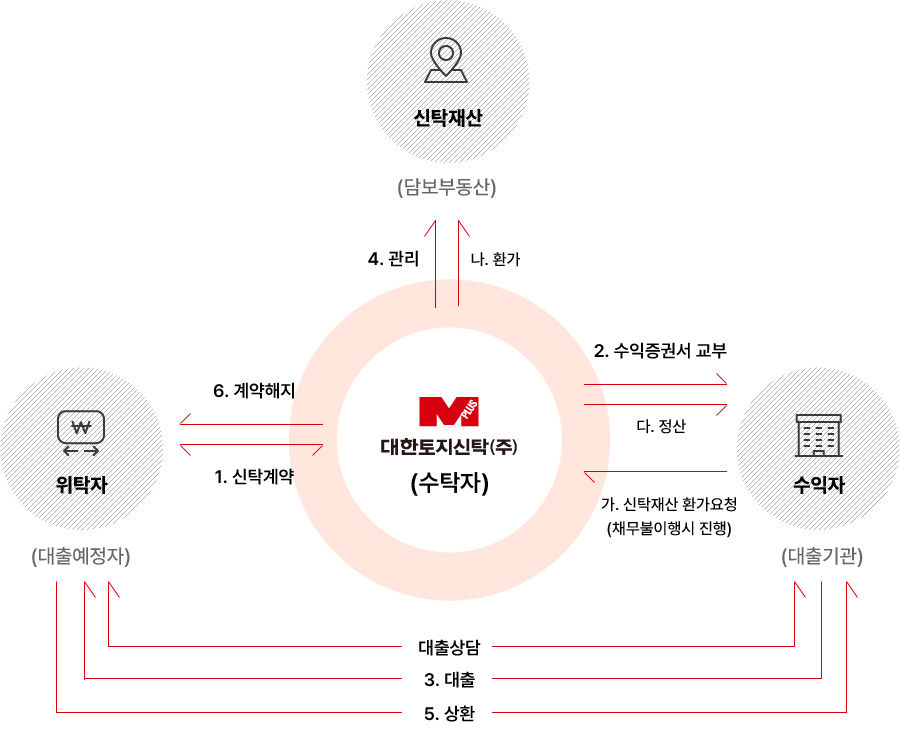Overview
What is a Collateral Trust?
A collateral trust is an advanced financial product that replaces mortgages. It is a product where real estate is entrusted to a trust company, the financial institution is designated as the primary beneficiary, and a beneficiary certificate is issued.
Business Structure

Advantages
An advanced financial product replacing the mortgage system
Rapid disposal possible through auction in case of default
Minimizes losses by disposing at market-accessible prices
Workflow
Click on each step to view more details.

01
Consult and negotiate on loans
- Consult and negotiate loan conditions between lending institution and trustor (debtor)
- Request real estate investigation and analysis from trust company upon loan approval

02
Investigate and analyze collateral real estate (Inspect documents, conduct on-site investigations)
- Investigate rent, tax arrears, senior rights, etc. by the trust company

03
Compile an investigation and analysis report
- Identify real estate status and effective collateral value based on site inspection and rights analysis
- Confirm final trust contract conditions with financial institution

04
Approve loan conditions and request the issuance of a beneficiary certificate
- Record appraisal status, planned loan amount, trust institution, beneficiary certificate amount, etc.

05
Sign a trust contract (Register trust)
- Conclude trust contract between trustor and trust company
- Transfer ownership to trust company (trust registration)

06
Issue and deliver a beneficiary certificate
- Issue beneficiary certificate and copy of trust contract to lending institution

07
Execute a loan
- Send loan execution notice to trust company after loan processing

08
Manage trust property
- Inspect management status on-site upon request of primary beneficiary and notify changes to primary beneficiary

09
Repay the loan
- Return beneficiary certificate to trust company after loan repayment

10
Terminate the trust contract (End the trust)
- Transfer (revert) ownership to trustor by trust company
Realization Procedure (In case of default)

01
Request for realization
- Request realization to trust company when realization factors occur, such as loss of benefit of time

02
Public auction for disposal
- Dispose through open competitive bidding after final demand for debt fulfillment to debtor by trust company
- Can request suspension of realization if necessary

03
Settlement
- Distribute realization proceeds according to the order specified in the trust agreement
- Can request suspension of realization if necessary
Comparison between Collateral Trusts and Mortgages
| Sort | Collateral Trust | Mortgage |
|---|---|---|
| Collateral Setting Method | Transfer of ownership to trust company | Establishment of mortgage right |
| Collateral Real Estate Management | Managed by trust company | Managed by lending institution |
| New Lease, Subordinate Rights Establishment | Can be excluded | Cannot be excluded |
| Occurrence of Priority Claims after Collateral Acquisition | Cannot occur after trust registration | Wage claims can occur |
| Debt Collection Method | Direct auction by trust company | Auction |
| Debt Collection Period | Short-term | Long-term |
| Debt Collection Procedure | Simple | Complex |
| Debt Collection Cost | Low | High |
| Real Estate Disposal Value | Relatively high | Low |
| Exercise of Subrogation Right | No prior seizure necessary | Prior seizure necessary |
| Property Rights Protection | Prevention of third-party rights infringement after trust registration | Third-party seizure possible (Junior mortgage, seizure, provisional attachment of real estate, etc.) |
| Debtor's Cost | Low | High |
| Forced Execution by Junior Right Holders | Selectively possible (with consent of senior right holders) |
It is possible for third-party creditors to apply for compulsory auction or junior mortgage holders to apply for voluntary auction |
| Additional Collateral | Easy to add additional collateral trust (Simple lot addition) |
New establishment contract required |
Problems with the current mortgage system
- Requires excessive time and cost for court auction, which is the method of executing mortgage rights
- Property loss of real estate owners due to low-price successful bids
- Difficulty in managing collateral objects
- Hindrance to the liquidation of real estate value







